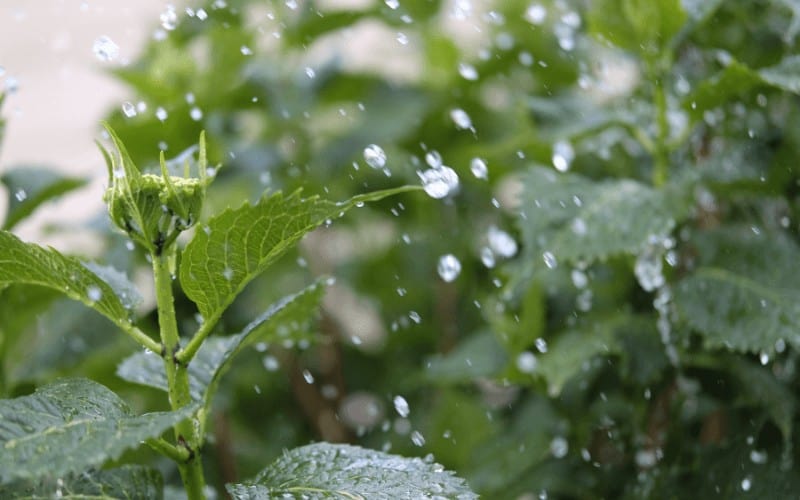How often should you water Hydrangeas? It's recommended to water Hydrangea at least, 2-3x per week during the summer season. But there are other things you should know, which we'll look at below.
Water is an essential requirement for any plant to grow healthy, and hydrangeas are no exception to this.
If you want to know how often you should water hydrangeas, we have given detailed information about watering these plants in this article.
Hydrangeas need different watering routines at different stages – from planting the new plants up to when they are established.
Irrespective of which Hydrangea you are cultivating, it is necessary to understand the watering needs of the plant.
In Greek, the word "hydrangea" means "water vessel." So it will not be surprising to know that they have a high water demand. So, how much water do Hydrangeas need?
Let's find out!
Table of Contents
How Often Should You Water Hydrangeas?

After planting Hydrangeas, it is important to keep them watered until established. Thereafter, they should be watered regularly enough to keep the soil moist, especially during hot conditions.
If you have propagated Hydrangea using seeds, they will require more water at this point. Water will help them establish through roots -- and they require at least 3 times a week watering to supply sufficient moisture for them.
Hydrangeas prefer to be planted on moist, well-drained soil. In as much as they require water, they hate wet feet, so you’d want to avoid waterlogged soil.
It is a good practice to use 2-3 inches of hardwood for mulching the soil. This will help make the soil retain moisture.
Watering Established Hydrangeas
Depending on the type of Hydrangea you have cultivated, different types require different water needs.
Of all the different types, Hydrangea macrophylla usually requires the most water, while Hydrangea arborescens and Hydrangea quercifolia require less.
Typically, Hydrangea requires water twice a week during the summer season. Water them only either in the mornings or in the evenings. You should avoid overhead irrigation by all means, especially during the summer season.
During winter, Hydrangeas are dormant, so they do not require watering.
There are some conditions that you may go against this recommendation. One way to know when your Hydrangea requires more water than recommended is by observing their flowers and leaves.
If the leaves and flowers are drooping or withering away, respectively, the plant more than likely needs to be watered.
Read Also: How Much Water Does Cucumber Plant Needs Per Day?
How Do I Know If My Hydrangea Is Overwatered?
There are chances that you may get your plant overwatered and we shall be looking at a few signs of overwatered Hydrangea below. Overwatering can prevent your Hydrangea from reaching its full display and growth potential.
Overwatering hydrangeas affects the root in particular. They do not have deep roots. As a matter of fact, they do not form taproots.
Haven said that – you do not need to constantly water Hydrangea plant because frequent sprinklings simply encourage shallow and weak roots.
The following are ways to know when your Hydrangea is overwatered.
Root Symptom
One of the symptoms of overwatering is seen in the root. Decay at the root system is experienced in soil with poor drainage.
For example, Phytophthora root rot is mostly experienced in potted hydrangeas. This condition is caused by the activities of fungus that thrive in overly moist conditions.
What you should do in such cases is to make better drainage for your garden. If planted in pots, provisions for holes underneath the pot is necessary for drainage.
The physical way to tell if a root is affected by too much water is by observation. Remove a small amount of topsoil, and you will observe a brown and brittle root. You will also observe that the roots are mushy rather than firm.
Leaf Symptoms
Overwatering hydrangeas have adverse effects on the leaves. When the roots rot, the leaves become yellowish rather than dark, rich green leaves. This eventually leads to premature shedding of the leaves.
Another notable symptom is that leaves may grow too large, thus obstructing the chances of budding.
Flower Symptoms
The flowers are also not left out of this impact. The results from the inability of the root to function effectively. Flowers affected by overwatering fail to bud as expected.
What this means for Hydrangea is that they will have fewer flower clusters. In addition to this, you will also notice wilted flowers.
Read Also: How Much Water Does Citronella Plant Need?
How Much Water Do Hydrangeas Need | Conclusion
How often should you water Hydrangeas? Ideally, you should water your Hydrangea twice a week during the summer season. The exposure of your hydrangeas to sunlight, as well as the soil type, is also a determinant of how much water it will require.
The more the sun intensity, the more water the soil will require to stay moist.
Clay soils offer poor drainage and hold moisture; hence they require less frequent watering than sandy soils with less water retention.
Overall, if your hydrangea plants are placed on well-drained soil, partial sun, and moderate wind, weekly watering that saturates the soil and keeps it moist is likely sufficient. Besides, these are the best conditions growing this shrub.






